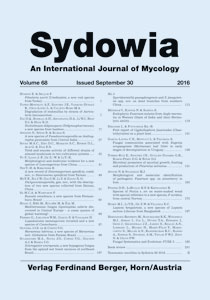
Endophytic Fusarium isolates from Aegle marmelos in Western Ghats of India and their fibrinolytic ability Vineet Meshram, Neha Kapoor & Sanjai Saxena Sydowia 68: 119–130 Published online on May 31st, 2016 Fusarium is an economically important fungal genus due to its pathogenic and endophytic behaviour. In the present study, endophytic fungi from Aegle marmelos (Rutaceae) growing in tropical rainforest of BRT wildlife Sanctuary, Yelandur, Karnataka, were isolated, characterised and screened for their proteolytic and fibrinolytic properties. The molecular phylogenetic analysis of the isolates using multilocus sequence typing (ITS, RPB2 and EF-1α) and geneological concordance phylogenetic species recognition approach indicated that Fusarium sp. NFCCI 2946 and Fusarium sp. NFCCI 2904 belong to Fusarium equiseti whereas Fusarium sp. NFCCI 2905 belong to Fusarium incarnatum. Morphological characters also suggested their specific identity as F. equiseti and F. incarnatum. Further, all the three isolates were found to be producers of proteolytic enzymes whereas only two isolates, Fusarium sp. NFCCI 2904 and Fusarium sp. 2905, were efficiently producing fibrinolytic enzyme. Both the isolates displayed bifunctional activities forming similar halos (94.98-125.81 mm2) over plasminogen rich and deficient plates. The present study also marks the first report of endophytic association of Fusarium incarnatum-equiseti species complex with Aegle marmelos. Keywords: EF-1α, fibrinolytic agents, multilocus sequence typing. |
 |